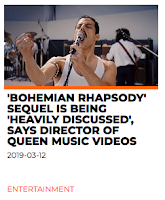Attitude online is the website version of the popular UK gay men's lifestyle magazine Attitude
- How is media language used in this product? Go through the textual analysis toolkit! Find explicit examples!
The layout is simple and easy to read meaning it focuses more on the information rather than being aesthetically pleasing. This can be said the same for the photograph used. The mise-en-scene of the article and magazine as a whole is not stereotypical to gay culture. For example, the colours are dark instead of being colourful. This portrays a more masculine/heterosexual atmosphere. The headline is straightforward and uses the abbreviation 'LGBTQ' which is a referential code for people in the gay community. The adverts shown in the magazine page do not have homosexual connotations, they are not related to any of the articles. This could be because they are purely for revenue purposes.
- How does this site create multiple meanings? How does it combine language to create meaning?
- Analyse the UX (user experience) of the site. How has it been constructed to maximise audience appeal and accessibility?
- The genre of this magazine website is gay men's lifestyle. What are the conventions/paradigmatic features of this genre? How do they work? What makes this a 'gay website' as opposed to a 'website'?
- How could audiences respond to and interpret all the stuff above?
- What is the ideology of the producer? How is this constructed through media language?
Gender Binary - the classification of gender into two distinct, opposite, and disconnected forms of masculine and feminine, whether by social system or cultural belief.
'Pink Pound' - the huge amount of money spent by those of gay or lesbian sexual orientation.
Subversive - refers to a process by which the values and principles of a system in place are contradicted or reversed
Heteronormative - is the belief that heterosexuality, predicated on the gender binary, is the norm or default sexual orientation. It assumes that sexual and marital relations are most (or only) fitting between people of opposite sex.
Anchorage - when a piece of media uses another piece of media to reduce the amount of connotations in the first, therefore allowing the audience to interpret it much more easily.
Androgyny - the combination of masculine and feminine characteristics into an ambiguous form. Androgyny may be expressed with regard to gender identity, sexual identity, or sexual lifestyle.
What sort of representations of masculinity are constructed by the front cover?
What traditional representations are are challenged?
Body Language - stereotypically feminine stance, with a hand on the hip, and the other over his face, with a smouldering facial expression. Subverts from typically masculine gender performativity.
Costume - Army influenced costume creates a binary between feminine and masculine stereotypes. Eg, soldiers are typically heterosexual, strong, masculine, which is opposed to the style in which it is worn, unzipped, with red nail varnish on his fingers, which almost sexualises the image, by creating feminine and promiscuous themes.
Make-up - use of eye shadow and mascara suggests that it is more complex than simple gender binary between what is male and female.
Anchorage - 'the masc. survey' putting more pressure on the audience questioning what is and isn't masculine. It mirrors themes in the image and anchors meaning to what is male and female.
Stuart Hall
- Suggests that the media and power of media representations play an important role in defining the ideological thinking of audience regarding specific social groups.
- Halls argument that stereotyping, as a form of representation, reduces people to a few simple characteristics or traits.
-Halls argument is that stereotyping tends to occur where there are inequalities of power, as subordinate or excluded groups are constructed as different or 'other'.
Find examples from Attitude online that support...
That Attitude constructs strong and positive representations of gay 'icons'.
This constructs a strong and positive representation of a gay icon Freddie Mercury, through creating positive connotations of the success of the film documenting his life and the band Queen, who were hugely iconic in their time, and continue to be today.
That the magazine represents contemporary issues that affect the LGBTQ community, for example, adoption and homophobia.
This article represents issues affected by the LGBTQ community, as they are represented to appear under attack by none their than the President of the USA. 'Military ban' creates violent and forceful connotations, representing transgender people as defenceless and vulnerable.
That the magazine self-stereotypes, appropriating and repurposing typical representations.
This creates a conflict within homosexuality and religion, two concepts that are binary, and do not typically go hand in hand. It self-stereotypes the gay community, as it reveals that church goers believe they can still have religion, however religious teachings normally teach that being homosexual is a sin. This repurposes typical representations of homosexuality and religion.
Find examples from Attitude online that support...
That Attitude constructs strong and positive representations of gay 'icons'.
This constructs a strong and positive representation of a gay icon Freddie Mercury, through creating positive connotations of the success of the film documenting his life and the band Queen, who were hugely iconic in their time, and continue to be today.
That the magazine represents contemporary issues that affect the LGBTQ community, for example, adoption and homophobia.
This article represents issues affected by the LGBTQ community, as they are represented to appear under attack by none their than the President of the USA. 'Military ban' creates violent and forceful connotations, representing transgender people as defenceless and vulnerable.
That the magazine self-stereotypes, appropriating and repurposing typical representations.
This creates a conflict within homosexuality and religion, two concepts that are binary, and do not typically go hand in hand. It self-stereotypes the gay community, as it reveals that church goers believe they can still have religion, however religious teachings normally teach that being homosexual is a sin. This repurposes typical representations of homosexuality and religion.







No comments:
Post a Comment